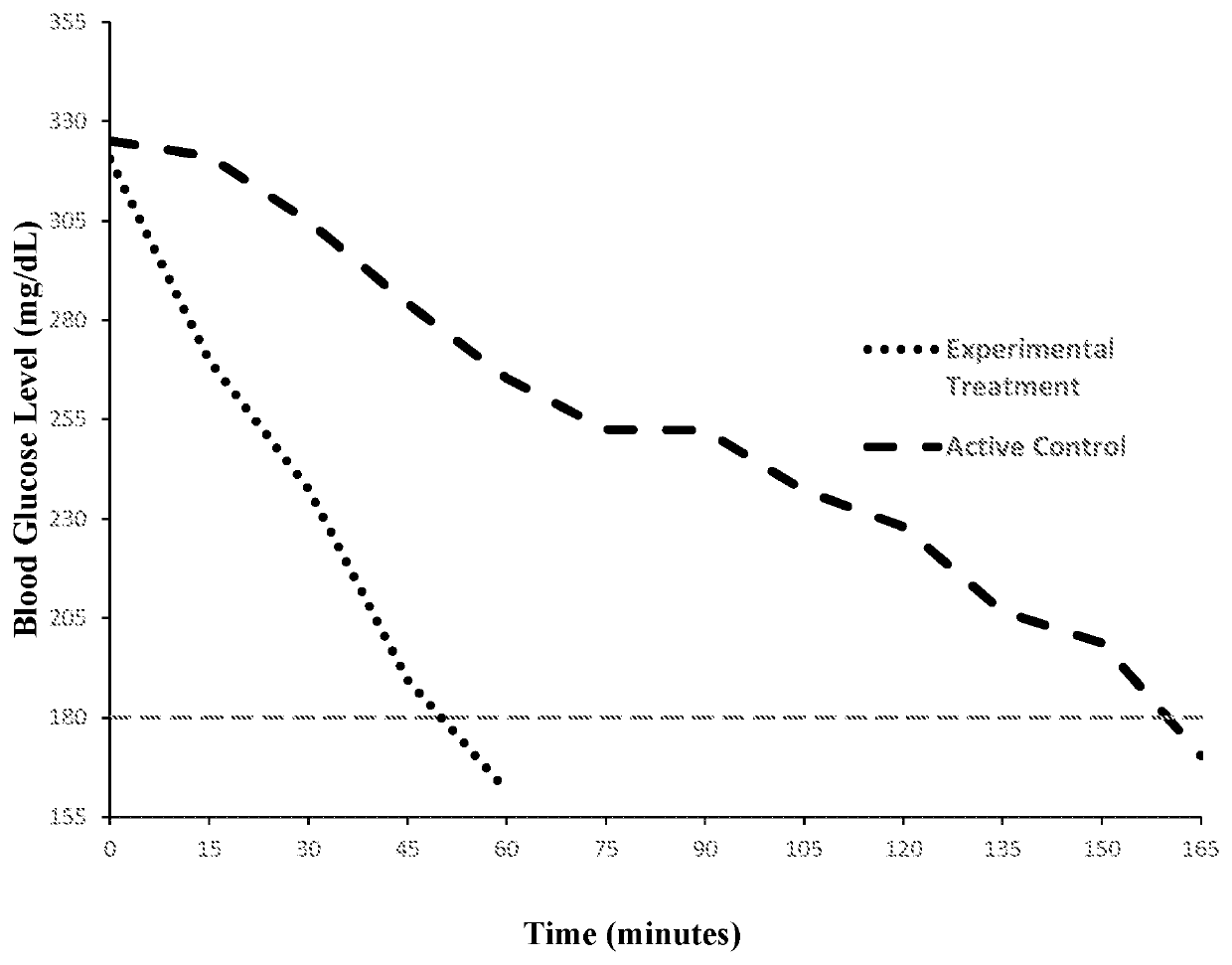Compositions and methods for reducing hyperglycemia and treating diabetes
a technology of hyperglycemia and composition, applied in the field of compositions for reducing hyperglycemia and treating diabetes, can solve the problems of difficult to achieve proper blood sugar management, insufficient processing, and a variety of dangerous effects of hypoglycemia on the health of diabetics, so as to reduce the likelihood of death, reduce the time a diabetic person spends, and reduce the effect of hospitalization
- Summary
- Abstract
- Description
- Claims
- Application Information
AI Technical Summary
Benefits of technology
Problems solved by technology
Method used
Image
Examples
example 1
[0132]An open-label pilot clinical study was conducted with two male Type 1 diabetic subjects. When the subjects were significantly hyperglycemic, they self-medicated by following either the active control procedure or the experimental procedure as described herein. Neither subject exclusively followed one of the treatment conditions; instead, sometimes a subject followed the active control procedure and other times the subject followed the experimental treatment procedure.
[0133]For the active control, the significantly hyperglycemic Type 1 subject consumed eight ounces of water, took insulin as appropriate in accordance with their habits and insulin pump recommendation, and waited until their blood glucose levels were no longer hyperglycemic. This is the current standard practice treatment among Type 1 diabetics. Blood glucose levels were recorded at the outset and every 15 minutes after the intervention was commenced until blood glucose levels dropped to less than 180 mg / dL.
[0134]...
example 2
[0137]A six-month study was conducted with an adult male Type 1 diabetic subject weighing roughly 85 kg. When the subject's blood glucose level was greater than 200 mg / dL and the subject was aware of the hyperglycemia and had access to the experimental sodium compositions described herein, the subject regularly self-administered at least eight ounces of water along with a therapeutic dosage of one or more sodium salts administered at a dose of sodium between 10 mg sodium per kg body weight of said subject and 100 mg sodium per kg body weight of said subject, and took insulin if appropriate in accordance with his habits and pump recommendation. During this period, the subject was not hospitalized for any diabetic ketoacidosis events. The subject's hemoglobin A1C percentage was tested prior to commencement of the study and was 7.6. After the 6-month study, the subject's A1C percentage dropped to 7.2.
example 3
[0138]In one embodiment, an adult male Type 1 diabetic subject experiencing significant hyperglycemia was administered five units of bolus insulin, then was administered a composition comprising inactive ingredients, approximately 10 grams of sodium citrate, and approximately 1.7 g sodium chloride. The composition was dissolved in 8 ounces of water, and consumed by the subject. In less than 45 minutes, the subject's blood glucose level dropped below sub-hyperglycemic levels.
PUM
| Property | Measurement | Unit |
|---|---|---|
| Time | aaaaa | aaaaa |
| Time | aaaaa | aaaaa |
| Percent by mass | aaaaa | aaaaa |
Abstract
Description
Claims
Application Information
 Login to View More
Login to View More - R&D
- Intellectual Property
- Life Sciences
- Materials
- Tech Scout
- Unparalleled Data Quality
- Higher Quality Content
- 60% Fewer Hallucinations
Browse by: Latest US Patents, China's latest patents, Technical Efficacy Thesaurus, Application Domain, Technology Topic, Popular Technical Reports.
© 2025 PatSnap. All rights reserved.Legal|Privacy policy|Modern Slavery Act Transparency Statement|Sitemap|About US| Contact US: help@patsnap.com

